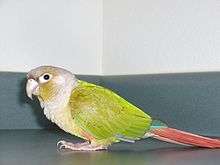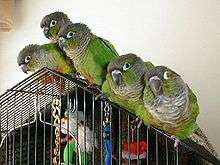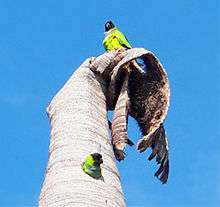Conure
Conures are a diverse, loosely defined group of small to medium-sized parrots. They belong to several genera within a long-tailed group of the New World parrot subfamily Arinae. The term "conure" is used primarily in bird keeping, though it has appeared in some scientific journals.[1] The American Ornithologists' Union uses the generic term parakeet for all species elsewhere called conure, though Joseph Forshaw, a prominent Australian ornithologist, uses conure.[2]

_-pet.jpg)

Description
Conures are either large parakeets or small parrots found in the Western Hemisphere. They are analogous in size and way of life to the Old World's rose-ringed parakeets or the Australian parakeets. All living conure species live in Central and South America. The extinct Conuropsis carolinensis, or Carolina parakeet was an exception. Conures are often called the clowns of the parrot world due to their constant attention seeking behavior including hanging upside-down and swaying back and forth or "dancing."
Despite being large for parakeets, conures are lightly built with long tails and small (but strong) beaks. Conure beaks always have a small cere and are usually horn-colored (gray) or black. Most conure species live in flocks of 20 or more birds. Conures often eat grain, and so are treated as agricultural pests in some places.
Conures are as diverse a group as African parrots, so trying to characterize them all is difficult and inaccurate. The category conure is loosely defined because they do not currently constitute a natural, scientific grouping. The term conure is now used mostly in aviculture. Scientists tend to refer to these birds as "parrots" or "parakeets". (See below under Scientific classification for more details.)
Conure Diet
Depending on the condition of the avian will dictate the dietary needs of the avian, such as, activity level, physiological condition, growth, breeding, egg-laying, rearing youth, and molting. Other then pellet mixes and seed mixes there are fresh foods that are acceptable for Conures to consume.[3] Healthy food:
| Category | Foods |
|---|---|
| Greens | chard,mustard, sorrel, cilantro, parsley, kale, collards, carrot tops, rapini, endive, arugula |
| Vegetables | pepper, squash, cauliflower, cabbage, carrot, beet, yam, pumpkin, snow pea, broccoli, kohlrabi, potato, cooked beans (e.g., garbanzo, kidney, peas, limas, black-eyed peas) |
| Fruits | apple, lemon, orange, grape, berries, banana, pear, plum, mango, cantaloupe, melons, papaya, fig |
| Pasta | various shapes, whole grain (wheat, spelt, etc.) |
| Grains | brown rice, barley, millet, amaranth, quinoa, farina, oats, corn |
| Nuts | Brazil nut, almond, walnut, pine nut, filbert, cashew, nut butters |
| Protein | tofu, chicken, salmon |
| Dairy | yogurt, cheese (small amounts) |
There are some foods that must be avoided and are very harmful, possibly, deadly are alcohol, avocado, caffeine, chocolate, cured meats, fatty or oily foods, salty food (including salted nuts), and sugared products.[4]
Conure species
Conures, as the term is used by aviculturists, include only the genera Aratinga and Pyrrhura, as well as several single-species genera and one double-species genus. These other genera are listed below:
- Conuropsis: Carolina parakeet (extinct)
- Cyanoliseus: Patagonian conure
- Enicognathus: austral and slender-billed conures
- Guarouba: golden or Queen Of Bavaria conure
- Leptosittaca: golden-plumed conure
- Nandayus : nanday conure—no longer in its separate species (Nandayus)—but now an Aratinga species
- Ognorhynchus: yellow-eared conure
Aratinga
Old Tupi for "bright macaw," (ara - "macaw", tinga "bright") the Aratinga conures generally seem to have a more mischievous personality than the real little macaws or mini-macaws. Popular as pets, the Aratinga conures are generally larger with brighter plumage and are generally the noisier, more outgoing, more demanding of the two primary conure genera. The colorful sun conure and jenday conure are among the species of conures more commonly kept as pets. Many of the Aratinga species can be quite loud but otherwise can make very good pets for responsible owners. Some species, such as the dusky conure, brown headed conure, peach front conure, and half moon conure, are among the quieter Aratinga species, though they may still be loud at times. Lifespan is 20–30 years.
See cherry-headed conure, blue-crowned conure.
Pyrrhura

Pyrrhura is the other prominent genus of conures. These conures (with generally more green colors) include the very common green-cheeked conure, as well as the maroon-bellied conure, pearly conure, black-capped conure, painted conure, crimson-bellied conure, and a number of other species. They are usually smaller, have more subdued colors, and are much quieter than the Aratinga conures. Pyrrhura species are growing in popularity as pet birds, primarily due to their quiet nature, their affectionate and intelligent personalities, and the increasing number of color mutations developed in several of these species. On average, Pyrrhura conures live around 20 or 25 years. To reach full maturity, many of them molt to rid themselves of feathers from previous growth stages, and - occasionally - young birds pluck their feathers during the winter.
Nanday conure

The nanday conure, nandayus nenday is the most commonly kept pet conure species outside the two main genera. Some experts believe that nandays should actually be grouped with the Aratinga genus, since they are cross-fertile with such species as jendays and suns. Nanday conures have a distinctive black head, and wings and tails tipped with dark blue feathers. They have a light-blue scarf and bright orange feathers on their legs and around their vents. The maturity of a nanday can be told by the edges of its black hood: if the hood has a ragged edge of brown, then the bird is over a year old. Nandays are often extremely noisy—they are a heavily flock-oriented species, used to making their demands known, calling out warnings for the group, and calling to members of the group who are out of sight. They are also extremely social and intelligent birds, capable of learning tricks, mimicking sounds, and learning a decent vocabulary. At least one report suggests that they are highly adaptable to human encroachment on their territories, but the exact status of the species in the wild is unknown.
Flocks of nanday conures live wild in parts of Florida, notably the west coast, including areas of St. Petersburg and Clearwater. Additionally, Flocks of wild Nanday conures Live in Siesta Key, Sarasota, Florida. A large flock of nanday conures lives wild in the Pacific Palisades neighborhood of Los Angeles. They have been in the area for the past several years.
Golden conure
The golden conure or Queen of Bavaria conure, Guaruba guarouba (recently reclassified from Aratinga guarouba) is, as the name implies, covered all over with bright yellow feathers, except for the green wing-tip feathers and the greyish horn-colored beak. Golden conures are among the most expensive conures both to purchase and to care for, although many owners feel that the benefits outweigh the cost. It is one of the rarest conures in the wild in addition to the pet trade. Many experts believe that these birds should not be kept in captivity unless in a breeding program.
Patagonian conure

The Patagonian conure, also known as the burrowing parrot, Cyanoliseus patagonus, is the largest conure. It can be found in the Patagonia region of south-central Argentina and Chile. Drab on the top, brightly colored underneath, the Patagonian conure has increased in popularity since the 1990s, leading to an increase in illegal importation that threatens wild populations; however, they are fairly commonly bred in captivity. Patagonian conures have a reputation for being exceptionally sweet-natured and intelligent conures, but can be very loud and destructive with their chewing. The greater Patagonian conure (Cyanoliseus patagonus bloxami or Cyanoliseus patagonus byroni) is the largest of all the conures. They learn to talk and they usually bond very well with people, especially if hand-raised, and although not the most colorful bird they make great pets.
Enicognathus
Composed of the austral conure, Enicognathus ferrugineus, which is native to the southern tip of South America and the slender-billed conure, Enicognathus leptorhynchus, endemic to Chile.
Golden-plumed conure
The golden-plumed conure, also called the golden-plumed parakeet, Leptosittaca branickii, is a small Andean conure not found in aviculture and endangered in its own habitat.
Yellow-eared conure
The exceedingly rare yellow-eared conure or Ognorhynchus icterotis of Colombia and Ecuador was never common in aviculture and has not successfully bred in captivity.
Carolina parakeet
Conuropsis carolinensis, the Carolina parakeet, was one of only two parrot species endemic to the United States in recorded history. The Carolina parakeet was a remarkably social bird, living in vast flocks. American bird hunters reported that Carolina parakeets would return to mourn dead members of the flock, making themselves easy targets. Considered a pest, popular in the pet trade, and bearing plume feathers valued for hats, this species was hunted to extinction around the beginning of the 1900s.
Gold-capped conure
Gold-capped conures (Aratinga auricapillus)—also known as golden-capped parakeets—are native to Brazil and Paraguay. Their natural habitats include subtropical or tropical dry forests, subtropical or tropical moist lowland forests, dry savanna, and plantations. The existence of this conure is threatened by habitat loss. However, gold-capped conures are prolific breeders, making them popular birds in aviculture, and hand-fed golden cap babies are generally available.
The gold-capped conure grows to about 13 to 14 inches in length and weighs about 150 grams. Their bodies are mainly green with blackish bills, gray feet and brown irises. The forehead, the areas around the eyes and underwing coverts are usually red. The breast feathers are a red and green mix. Their tail feathers are olive green with a bluish tip. The primary feathers, wing coverts, and under-wing coverts are blue.
Immature gold-capped conures are mostly green, with some orange around the eyes, above the beak, and on the breast near the wings. Some navy is mixed in with the green of the tail. The bird's full coloration is not seen until they are sexually mature at about two years of age.
Their lifespan is about 30 years.
Scientific classification
The word conure is an old term that originally described members of the no longer-used genus conurus, which included members of aratinga and pyrrhura.
The parrot order, Psittaciformes, is a tangle of genera, many containing only one species. Parrots include about 353 species of bird—generally grouped into two families: the Cacatuidae or cockatoos, and the Psittacidae or true parrots. The term parrot generally applies both to the entire order and to Psittacidae alone.
All members of the Psittaciformes order have a characteristic curved beak shape with the upper mandible having slight mobility in the joint with the skull and a generally erect stance. All parrots are zygodactyl—meaning they have four toes on each foot: two that face front and two that face back.
Conures and all other New World parrots are often placed in a subfamily or tribe Arinae. Internal relationships of conures are poorly understood though it seems evident that, to make them a natural grouping, the quaker parakeet,[5] the thick-billed parrot, and Brotogeris[6] should be included, and often are. Neotropical parrots, macaws, and other are also candidates potential for inclusion. In this scheme, "conure" comprises members of the genera:
- Aratinga
- Pyrrhura
- Nandayus (now an Aratinga species)
- Guarouba (Queen of Bavaria conure or the golden conure as it is sometimes called)
- Cyanoliseus
- Enicognathus
- Leptosittaca
- Ognorhynchus
- Conuropsis
- Rhynchopsitta: thick-billed parrot
- Myopsitta: quaker parakeet
Macaws:
- Ara
- Anodorhynchus
- Cyanopsitta
- Diopsittaca
- Orthopsittaca
- Primolius
In addition the caiques and the hawk-headed parrot have also been proposed for inclusion. Both the caiques and the hawk-headed parakeets have a heavier build and different tail structure from traditional conures.
Trivia
A blue-crowned conure was the star of the family movie Paulie. The film used 14 different birds.
Nonnative conure colonies
Conures are highly adaptable to urban environments, and several nonnative colonies have been observed globally. The exact origins of such colonies are generally unverifiable.
Honolulu, Hawaii
A colony of cherry-headed conures lives around the slopes of Diamond Head.[7]
Seattle, Washington
A conure colony lives in Seward Park.
San Francisco, California
A colony of cherry-headed conures lives on Telegraph Hill, San Francisco. They are the subject of a film, The Wild Parrots of Telegraph Hill, based on a story by Mark Bittner. Pairs of conures can be seen and heard in many other areas of San Francisco such as the Tenderloin district.[8]
Santa Clara County, California
Multiple colonies of cherry-headed and/or mitred conures thrive in and around Santa Clara County, California. In particular Sunnyvale,[9][10][11] Cupertino (especially around the Apple Campus),[12] and Palo Alto.[8]
Los Angeles, California
Multiple colonies of cherry-headed conures live in the San Gabriel Valley (the suburbs northeast of Los Angeles). Subtropical U.S. cities like Los Angeles are great environments for tropical birds because of all the tropical plants that are cultivated as ornamentals, providing them with their natural food supply. Flocks of fifty or more descend on fruit trees during their bearing season, staying for a few days and making a deafening racket. During mating season they build nests in the palm trees that line many streets in the region.
Three species of conures (genus Aratinga) have formed non-native colonies in California. These are documented by the California Parrot Project in affiliation with the Natural History Museum of Los Angeles County, and in cooperation with the Pasadena Audubon Society.
Long Beach, California
A colony of half-moon conures has been observed in the Belmont Shore area of Long Beach, California since the late 1980s.
Delray Beach, Florida
A least one wild pair of nandays has been spotted in downtown Delray Beach, Florida. The total number of birds in the colony is yet undetermined.
Quakers
The Quaker (which may or may not be a conure) can be found in many states. Quakers are also illegal to own in many US states as they are known to build very large nests on powerlines (Quakers are the only parrots who builds nests).[13]
See also
References
- ↑ Buhrman-Deever, Susannah C.; Hobson, Elizabeth A.; Hobson, Aaron D. (2008). "Individual recognition and selective response to contact calls in foraging brown-throated conures, Aratinga pertinax". Animal Behaviour. 76 (5): 1715. doi:10.1016/j.anbehav.2008.08.007.
- ↑ Forshaw, Joseph M.; Cooper, William T. (1978). Parrots of the World (2nd ed.). Melbourne Australia: Landsdowne Editions. ISBN 0-7018-0690-7.
- ↑ Vriends, Matthew M., Ph.D. (1998). Conures. Barron's. p. 29. ISBN 0-7641-1038-1.
- ↑ Frischmann, Carol. (2007). Conures. T.F.H. Publications. pp. 51, 55. ISBN 978-0-7938-3770-0.
- ↑ The quaker or monk parakeet is technically a conure by almost anybody's definition, but due to its popularity in aviculture and its uniqueness, it is generally considered in a category of its own.
- ↑ Brotogeris are not only often counted as conures, but as parrotlets as well, and it is not clear precisely which one, or both, or neither, they belong to. The tail structure is different from the parrotlets, though the basic body structure is the same in both groups.
- ↑ "Tracking Oahu's wild parrots – Hawaii News Now – KGMB and KHNL". Hawaii News Now. Retrieved 2015-02-14.
- 1 2 "Feral Parrot populations in San Francisco". Fog.ccsf.cc.ca.us. 1998-03-12. Retrieved 2015-02-14.
- ↑ "Cherry Heads Image". Conure Community. Archived from the original on September 5, 2014.
- ↑ "Wild parrots of Sunnyvale". YouTube. 2009-08-03. Retrieved 2015-02-14.
- ↑ "GC1V23Z Wild Parrots of Sunnyvale (Traditional Cache) in California, United States created by GoGoJo". Geocaching.com. Retrieved 2015-02-14.
- ↑ "Wild parrots in Cupertino. | Flickr – Photo Sharing!". Flickr. 2009-12-09. Retrieved 2015-02-14.
- ↑ "Why Does The Quaker Parrot Get Such A Bad Rap?" (PDF). Bird Channel.
External links
| Wikimedia Commons has media related to Psittaciformes. |
| Wikispecies has information related to: Psittaciformes |
